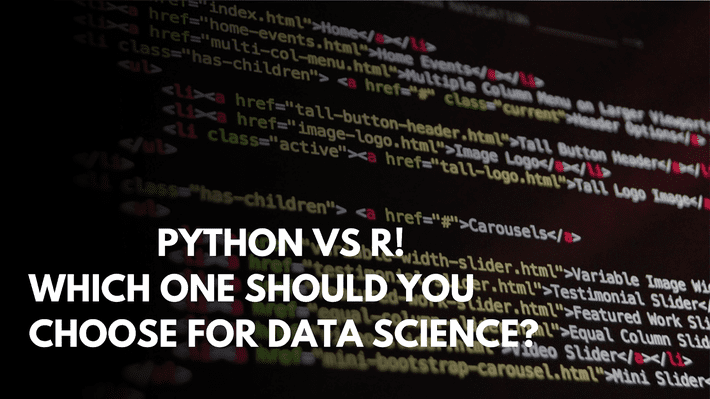
Increased consumption of data, more powerful computing, and the strong inclination towards data-driven decisions in business have made data science a crucial part of today’s business environment. According to IBM, there is a huge demand for data scientists and data analysts in the present time.
Python and R are the two most popular tools for programming for data science. Python and R both are open-source and free and were developed back in the early 1990s. For practitioners of machine learning and data science, these two tools are absolutely essential.
While both R and Python are competing to be the data scientist’s language of choice, it’s very hard to decide any one of them. So, in this article, we will be doing a comprehensive comparison between Python and R.
A Brief Overview of Python and R History

Python
Python was released back in late 1989 with a belief that emphasizes code readability and efficiency. Python is an object-oriented programming language, which means, it groups the code and the data into objects that can interact with one another. This modern approach allows data science practitioners to perform their work with better stability, code readability, and modularity.
Python’s suite of libraries includes popular tools like Keras, sci-kit-learn, and TensorFlow, which allows data scientists to develop advanced data models.
R
R is a procedural language developed back in 1992 and it remained the data scientist’s preferred programming language for years. R serves tonnes of advantages when it comes to building data models because it makes it easy to understand how complicated operations are carried out; however, at the loss of performance and code readability.
To help data science practitioners, R’s analysis-oriented community has developed open-source packages for specific complex models that a data scientist would otherwise have to build from scratch. R also maintains quality reporting with support for clean visualizations and frameworks for creating interactive web applications. Though there are few problems with R like a lack of key features like web frameworks and unit testing and slow performance.
Now, let us try to understand the usage of both R and Python in the data science process:
- Data Collection
- Data Exploration
- Data Modeling
- Data Visualization
Data Collection
Python
Python supports various kinds of data formats, be it CSVs or JSON sourced from the web. Even SQL tables can be directly imported into your code. Python’s requests library allows users to take data from different websites with just a line of code.
R
You can import data from CSV, Excel, and Txt files into R. SPSS and Minitab format files can also be turned into R data frames. Though R is not as versatile as Python at grabbing information from the web, it can handle data from all the common sources.
Data Exploration
Python
Python provides us data analysis libraries like Pandas to discover insights from the data. With this, you can sort, filter, and display data in a matter of seconds and the best part is that it can handle large amounts of data without any lags.
Pandas is formed into data frames, which can be redefined several times during a project. When required you can also clean the data by filling in non-valid values i.e, NaN (not a number) with a value that makes sense for numerical analysis.
R
R was primarily built for numerical and statistical analysis of large datasets, so no wonder it has so many options while doing data exploration. You can apply a variety of statistical tests to your data, build probability distributions, and use standard data mining and machine learning techniques.
Basic R functionality incorporates the basics of analytics, signal processing, statistical processing, random number generation.
Data Modeling
Python
Python has a library known as Numpy which you can use to do numerical modeling analysis while for calculation and scientific computing you can use SciPy which is open-source Python-based software for science, mathematics, and engineering. You can access tonnes of machine learning algorithms with the Scikit-learn library. Scikit-learn has an intuitive interface that allows you to tap into the power of machine learning.
R
To do special modeling analyses, sometimes you will have to rely on packages outside of R’s core functionality as it doesn’t have one of its own. Though there are loads of packages out there for analyses such as the Poisson distribution and mixtures of probability laws.
Data Visualization
Python
The IPython Notebook has tonnes of options to visualize data. To generate basic charts and graphs from the data embedded in your Python you can use the Matplotlib library. And in case you want more advanced graphs you can go for Plot.ly. It takes your data through its intuitive Python API and splutters out amazing graphs and charts that can help you manifest your point just exactly as you want it to.
R
When it comes to statistical analysis and demonstrating the results, R easily wins the game. R is best suited for scientific visualization and comes with several packages specially designed for the graphical display of results. With the base graphics module, you can make all of the basic plots and charts from the data matrices. And for complex scatter plots with regression lines, you can use ggplot2.
Conclusion
Python is a versatile programming language that you can pick up pretty easily even when you don’t have much experience with programming. Python can be used for a variety of tasks and learning it will immensely help you in your data science career.
On the other hand, R is specially designed for data analysis which is an integral part of data science. Learning R is crucial if you want to make a long-lasting career in data science.
Frankly, learning both R and Python is crucial and both have their respective uses and strengths.
